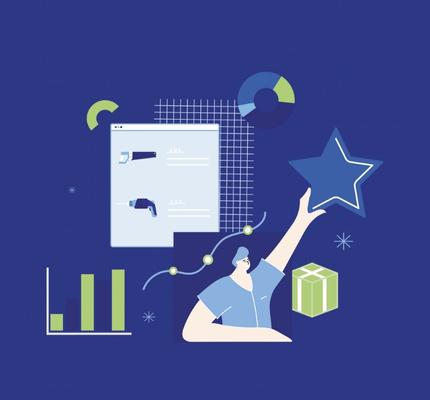
Article
The Best Post-Purchase Email Flow to Increase Customer Lifetime Value
By Juliana JacksonThe lack of valuable content, post-purchase personalization, and dirty data cause most DTC brands to churn 75-80% of their customers after just one order. Direct to consumer brands…
By Juliana Jackson
The lack of valuable content, post-purchase personalization, and dirty data cause most DTC brands to churn 75-80% of their customers after just one order. Direct to consumer brands acquire low and high-value customers every month. However, most of them (based on aggregated data from 1200+ Reveal users) lose 70-85% of new customers after their first order.
Industry-wise, the chances for new customers to buy again are pretty steep. Check out these customer retention benchmarks across 1200+ Shopify Stores.
So you are probably asking yourself: How do I make a postpurchase email?
Building a post-purchase email flow based on NPS survey responses allows you to increase customer satisfaction. Being connected with your customers’ feelings and thinking about your products and services will enable you to be more agile in addressing their complaints and in understanding post-purchase behaviors.
Why should you use NPS to build post-purchase email flows?
Net Promoter Score (NPS) is one of the most straightforward ways to measure customer satisfaction, and email marketing enables an easy way to send the NPS surveys.
One of the most significant advantages of using NPS to measure customer satisfaction is that your company can treat objections in real-time. NPS tool automation and integrations allow you to send tickets to customer support right away so your teams can address complaints as soon as possible.
How should an email post-purchase flow look like to collect and increase customer satisfaction?
Once the order is placed, email becomes one of the most important communication and engagement channels with your customer.
Well, in general, that is the purpose of the email. To be an engagement channel, not a revenue generation channel. The revenue is just an outcome of doing those things right.
We all know what goes through our minds when we place an order, especially when we order for the first time from a new brand. It’s called post-purchase c
What is post purchase dissonance?
We’re on a rollercoaster that takes us from uncertainty and doubts to the enthusiasm and hopes that the solution we’ve just ordered is going to make our lives better.
Email marketing helps you reassure the customers that they made the best choice when they choose to buy from you, and you are there to support them at every step.
Ok, so this is how it looks and how you can do it.
Before we get started, my advice is to unassign all the new customers bought from you for the first time and haven’t received their order yet, from any promos, campaigns, retargeting… basically anything unrelated to their order.
Why? Because otherwise:
- You will annoy them with your recommendations for new purchases when they didn’t even receive their products yet;
- You will show that you don’t care that they didn’t get their order yet. You only want to make $$$
- you will increase your ticket numbers and overwhelm your customer support team;
- Customer satisfaction will go down in pieces;
- You might experience a lot of unsubscribes;
- You will lower their chances to place a second order because of all of the above.
Instead, based on your shipping times, create a nurturing flow with emails or communication related ONLY to their order 🙂
Once they receive it, they have time to experience the products, and after you measure their happiness with you and your products, you can go ahead and drop that 20% off campaign that y’all love so much on them.
This is a very underrated strategy to keep some money in the house.
OK, let’s get to it.
Email 1: Sent instantly – Thank-you and order confirmation
These emails have the highest open rate because they tap into the cognitive dissonance that happens immediately after someone purchases from a new company for the first time.
To build and maintain trust, you need to send the first email instantly. Based on the customer attributes, you recap what they ordered and the estimated delivery time. It’s also an excellent time to remember your shared values, what your mission is as a brand in a way that is credible and meaningful for your customers.
* I have a sneaky strategy that improves onboarding and Customer Lifetime Value, but I will save that for another article.
Email 2: After a couple of hours – welcome to the community
In the second email, sent a couple of hours after the order confirmation email, you can thank your customers personally, ensure they have a warm onboarding, and tell them how they can get in touch with your company anytime they need you. Also, mention to them that they will receive an email containing the tracking number for their order once it’s shipped.
Short pitstop:
I would make the shipping & delivery information an email of its own.
Why? Because fulfillment, shipping, and everything related to this are one of the biggest industry problems. Most of the customers’ issues occur from long shipping times, which the brand doesn’t communicate.
Tip: Send this email from your customer support email address. This will help your customers understand and feel that they have access to you whenever they need it.
Bonus: Sign the email using the name of one of your customer support reps.
Suggested format:
Headline: Important Information about your order
Body:
Hi, Customer name,
This is John from Customer Support!
We are very excited that you decided to give our products a go!
Because we want to make sure you are informed about all our policies regarding shipping and delivery, please see below all the info you need about this topic.
{enter your policies here}
If you have any questions, just reply to this email or if you want to have a chat, just call us at {insert phone number}.
Chat with you soon,
John from {Brand name}
Ok, now back to the flow…
In this onboarding email, you could also include a hook for a series of tips to resolve their biggest pain points. It could be sent as a quiz with multiple answers, where each answer reflects a customer’s expectation. Based on their answers, you’ll be able to choose the best UVP and target them with the best remarketing campaigns via paid ads or content flow emails once they have received their item and you have tracked their satisfaction with the item and your brand.
Email 3: Educational content around their pain points
While the customers wait for their order to arrive, you can use it to bring more value and maintain their enthusiasm for the product. It could be an educational video on YouTube or any other resource that shows your ability to support your customers with valuable content. You can also use this step to find more about their preferences via a short quiz and transform their answers into customer attributes that you can use in future remarketing campaigns.
Email 4: Shipping Confirmation Email
With “Where is my order?” Being the most frequent question people ask in the pre-delivery phase, the shipping confirmation email is a must-have. Its’ place in the email flow might vary, but it’s vital to let your customers know how they can track their delivery. A transparent and consistent communication will contribute to higher customer satisfaction.
PS: If you sent my previous email from point 2, you could follow up as “John the Customer Support Rep” to tell the customer that his order was shipped.
Email 5: A couple of days after delivery – Post-delivery NPS
The post-delivery NPS email is key for your customer satisfaction efforts. It allows you to measure your customers’ sentiment shortly after using your products or services.
Your future communications will flow differently depending on their responses to the NPS surveys:
- If the NPS is between 0 and 7, you are talking to detractors.
The next thing you want to do is find more about their experience and resolve any customer complaint. Exploring the reasons behind their dissatisfaction allows you to avoid making the same mistakes in the future.
Here is where you should ideally receive the NPS responses directly in Gorgias, Zendesk, or other Customer Support tools that you might use. This way, you can address customer issues in real-time without taking a hit on Customer Satisfaction and CLV.
Next, you can send them an invitation to join the referral program or the loyalty program.
Then, two days after their NPS response, you can send them a review request for the products or services they had the chance to use.
One week later, you can suggest a better product or service based on their latest order as part of your upselling efforts. But be careful; you want to bring more value, not to seem too pushy.
Based on your business model and metrics, such as average days between transactions or purchase frequency, you can design an email marketing flow between orders, mixing educational content with relevant offers for your customers.
Customer Profiling/ Quiz
Another essential part of the post-purchase journey that isn’t necessarily related to email efforts is customer profiling. This helps you collect more data points about your customers through quizzes and pop-ups to create a customer profile. Having a customer profile can allow you to build personalized journeys for your customers.
Wrap up
This is one of the possible workflows that help you create post-purchase email flows for your customers, measure their NPS, and make sure you keep the customer satisfaction levels high throughout the relationship.
You can support your customer satisfaction efforts by integrating your NPS solution with your email marketing tool, customer loyalty solution, and eCommerce platform. To learn how you can adapt the journey to each customer segment, we recommend you take the CVO course, where Valentin Radu details the blueprint that helps you nail customer journey optimization. Read this online here.

